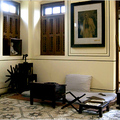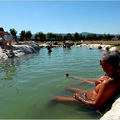
In the 1920s, the architect Sir Clough Williams-Ellis built Portmeirion to give a touch of the Italian Riviera to North Wales. He was still tinkering 50 years later.
ALONG an estuary at the northwest tip of Wales, a one-hour hike through a hill town called Portmeirion can lead past a pagoda-shaped chinoiserie gazebo, some Gothic pinnacles, eucalyptus groves, a crenelated castle, a Mediterranean bell tower, a Jacobean town hall, and an Art Deco cylindrical watchtower. And watch your head while you duck through some archways and doors because they are four-fifths of normal scale.
Portmeirion is actually a resort where no one has ever lived. A self-taught Welsh architect named Sir Clough Williams-Ellis built it from architectural salvage from the 1920s to 1970s, loosely based on his memories of trips to Portofino on the Italian Riviera. He kept improving Portmeirion until his death at age 94 in 1978. In his long career, he designed almost nothing else memorable, except some country houses for British aristocrats.
Portmeirion now belongs to a charity, run by Sir Clough’s grandson, Robin Llywelyn, a Welsh novelist who is the co-author of a gloriously illustrated and lively history, “Portmeirion” (Antique Collectors’ Club, 2006). The family dutifully maintains the 50 bright-colored buildings and has even brought them a bit upscale the last few years, hiring Sir Terence Conran to redecorate some public spaces in a taupe and celadon palette. But no renovation has yet tamped down the abiding weirdness of Portmeirion, which is surrounded by gray slate hills and gray slate villages. When I mentioned my planned trip to a Welsh friend, I was a little nervous that he would consider it a Disney-fied tourist trap, but instead he went wide-eyed and nostalgic. “It’s an absolutely batty place,” he said. “We got married there.”
In the summer high season, about 200 guests a night pack into Portmeirion’s two hotels and dozens of rental cottages. Another hundred or so pay £6.80 ($13.60 at $2 to the pound) just to stroll the grounds. Sir Clough (pronounced CLUFF) wrote gleefully in his 1971 autobiography that he knew visitors might “find it all insufferably chaotic, contrived, whimsical or out of place.” He wanted them to at least remember the place, which had a polemic subtext: he hated his era’s taste for modernist architecture.
When he started building Portmeirion, the rectilinear glass walls of Le Corbusier and Mies van der Rohe were becoming fashionable, but “their work seems to me to be so unfeeling,” he said. He called the resort “a home for fallen buildings,” and its ragged skyline and playful narrow passageways were meant to provide “more fun for more people.”
An aristocrat who declared ancestry from a 12th-century king, Sir Clough was such a committed neotraditionalist that he dressed in breeches and waistcoats. When he wasn’t tweaking Portmeirion, he often proselytized pro bono for environmentalist causes; he was an early promoter of wind farms, bike paths, national parks and bans on billboards.
Modernist critics like Lewis Mumford dismissed Portmeirion as “a monumental joke” or “ridiculous Welsh fantasy,” but the British government declared it a protected landmark in 1971, and it seduced tourists as well. “Its economic success has staggered me,” Sir Clough declared near the end of his life. Mr. Llywelyn’s book, which contains a loving essay by the travel writer Jan Morris, who lives nearby, lists bold-face visitors including Bertrand Russell, the Duke of Windsor, King Zog of Albania, and the actor Patrick McGoohan (his creepy 1960s TV series “The Prisoner” was filmed at Portmeirion). Noel Coward wrote “Blithe Spirit” at a Portmeirion cottage in a five-day sprint in 1941 (he’d been suffering from writer’s block in London, where his home had been destroyed during the Blitz), and the Beatles manager, Brian Epstein, spent a few summer vacations in a suite tucked above a Portmeirion archway.
The celebrities returned year after year, partly to see what Sir Clough had newly wrought. He kept teams of carpenters and masons on call. They never knew what salvage delivery would arrive next: gilded statues of Burmese goddesses, 18th-century cannons, a Victorian sandstone fireplace, a 1640s ballroom ceiling. Wherever an appropriate antique wasn’t available, Sir Clough improvised: many windows and pilasters are trompe l’oeils, painted illusions, and the domes on the lighthouse and the town hall are both made from overturned pig boilers.
Staff gardeners meanwhile lined paths with formal topiary rows and palm trees. They also set aside 70 acres for unkempt stands of tree ferns, redwoods, gingkos and rhododendrons (Gulf Stream currents in the estuary make for a subtropical microclimate). The contrast between the architecture and the exotic groves is surreal: in an essay in Mr. Llywelyn’s book, the British garden writer Stephen Lacey describes “the magical shock of exchanging bustling Riviera for silent rainforest in a single step.”
On my own all-too-short two-day visit a few months ago, I mostly clambered along hairpin turns in the village’s cobblestone paths, puzzling over Sir Clough’s inventions, stage-set tricks and juxtapositions. After a while, I pitied the maintenance crews, and said as much to Mr. Llywelyn, when I called his office for an interview after my incognito trip.
“I don’t think my grandfather realized how long this place would be popular, how long the buildings would be expected to withstand the sea air and winds here,” he said rather wearily. Nor have his grandfather’s furnishings choices held up well, he added: “Especially the four-poster beds in the guestrooms, those were, unfortunately, quite creaky, quite narrow and so uncomfortable.” I didn’t have the heart to tell him that the Conran-inspired replacement beds, with leather-upholstered headboards, seem hopelessly generic in such a loopy place.
The regulars and celebrities aren’t fazed by the changes, apparently. Portmeirion is booked solid for August; Welsh and English families return annually to the same cottages, which have cute names like Salutation, Neptune and Unicorn. (Consider a fall trip, so you can reflect on the season’s shortening days at a town constantly battling decay.) Sightings of Jude Law and Liam Neeson, Mr. Llywelyn told me, have been reported in the last few years.
But I saw no one even faintly fabulous, just serious hikers with water bottles dangling from backpacks as they headed into the faux wilderness and khaki-and-loafer-wearing hotel guests photographing one another along the colonnades or browsing the gift shops. The souvenir stock, I found, was rather perfunctory, dominated by “Prisoner” memorabilia and mermaid-logo pencils and magnets. So instead I picked up a pinky-size fragment of stucco painted turquoise from a housekeeper’s pile of sweepings of palm fronds and pebbles.
No one saw me pocket this treasure, but I felt compelled anyway to confess the looting to Mr. Llywelyn. He said he didn’t mind at all, he’d heard similar stories before. Still, I felt better that he knew a salvaged piece of his grandfather’s 50-year salvage operation had reached New York. I keep the artifact next to my computer, in case I am ever tempted to think that my trip to Portmeirion was a dream.
VISITOR INFORMATION
Portmeirion is a two-hour drive from Manchester, Liverpool and Birmingham and nearly five hours from London (see www.portmeirion-village.com for directions). Trains (www.britishrail.com) to the nearest major stop, Bangor, are three and a half hours from London (starting at £68 round trip, or $136 at $2 to the pound) or two hours from Manchester (starting at £28.80). The hotel can arrange taxi service (£50) for the one-hour drive from Bangor.
Summer nightly rates for rooms in the cottages (some of which require weeklong stays) and two hotels (Castell Deudraeth, a crenelated Victorian folly, and the Hotel Portmeirion, a bow-fronted Victorian villa) are £167 to £277. Each hotel has a formal restaurant. A half-dozen snack bars and food shops are scattered around the village.






